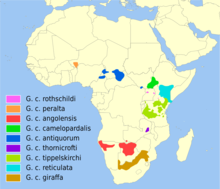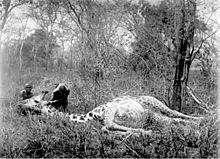GIRAFFE
GIRAFFE
 |
| Range map of extant Giraffa species. |
The giraffes (Giraffa camelopardalis) are an African even-toed ungulate mammal, the tallest living terrestrial animal, and the largest ruminant. They are specific name refers to its camel-like face and patches of color on a light background, which bears a vague resemblance to a leopard's spots. The giraffes are also noted for its extremely long neck and legs and prominent horns. They stand 5–6 m (16–20 ft) tall and have an average weight of 1,200 kg (2,600 lb) for males and 830 kg (1,800 lb) for females. they are classified under the family Giraffidae, along with its closest extant relative, the okapi. There are nine subspecies, which differ in size, coloration, pattern, and range.
Giraffes are the world's tallest mammals, thanks to their towering legs and long necks. A giraffe's legs alone are taller than many humans—about 6 feets. These long legs allow giraffes to run as fast as 35 miles an hour over short distances and cruise comfortably at 10 miles an hour over longer distances.
Giraffes have spots covering their entire bodies, except their underbellies, with each giraffe having a unique pattern of spots. Giraffes have long necks, which they use to browse the leaves of trees. They also have slightly elongated forelegs, about 10% longer than their hind legs. Like nearly all mammals, a giraffe has seven neck vertebrae, which are extremely elongated. These bones produce bud like horns called ossicones.
Typically, these fascinating animals roam the open grasslands in small groups of about half a dozen.
Bulls sometimes battle one another by butting their long necks and heads. Such contests aren't usually dangerous and end when one animal submits and walks away.
Giraffes use their height to good advantage and browse on leaves and buds in treetops that few other animals can reach (acacias are a favorite). Even the giraffe's tongue is long! The 21-inch tongue helps them pluck tasty morsels from branches. Giraffes eat most of the time and, like cows, regurgitate food and chew it as cud. A giraffe eats hundreds of pounds of leaves each week and must travel miles to find enough food.
The giraffe's height also helps it to keep a sharp lookout for predators across the wide expanse of the African savanna.
The giraffe's stature can be a disadvantage as well—it is difficult and dangerous for a giraffe to drink at a waterhole. To do so they must spread their legs and bend down in an awkward position that makes them vulnerable to predators like Africa's big cats. Giraffes only need to drink once every several days; they get most of their water from the luscious plants they eat.
Female giraffes give birth standing up. Their young endure a rather rude welcome into the world by falling more than 5 feet to the ground at birth. These infants can stand in half an hour and run with their mothers an incredible ten hours after birth.
 |
| The extinct giraffid Samotherium (middle) in comparison with the okapi (below) and giraffe. The anatomy of Samotheriumappears to have shown a transition to a giraffe-like neck.[13] |
Giraffes have high adult survival probability, and an unusually long lifespan compared to other ruminants, up to 25 years in the wild. Because of their size, eyesight and powerful kicks, adult giraffes are usually not subject to predation, aside from lions. Giraffes are the most common prey for the big cats in Kruger National Park. Nile crocodiles can also be a threat to giraffes when they bend down to drink. Calves are much more vulnerable than adults and are additionally preyed on by leopards, spotted hyenas, and wild dogs. A quarter to a half of giraffe calves reaches adulthood. Calf survival varies according to the season of birth, with calves born during the dry season having higher survival rates. The local, seasonal presence of large herds of migratory wildebeests and zebras reduces predation pressure on giraffe calves and increases their survival probability.
Some parasites feed on giraffes. They often host for ticks, especially in the area around the genitals, which has thinner skin than other areas. Tick species that commonly feed on giraffes are those of genera Hyalomma, Amblyomma and Rhipicephalus. Giraffes may rely on red-billed and yellow-billed oxpeckers to clean them of ticks and alert them to danger. Giraffes host numerous species of internal parasite and are susceptible to various diseases. They were victims of the (now eradicated) viral illness rinderpest.[7] Giraffes can also suffer from a skin disorder, which comes in the form of wrinkles, lesions or raw fissures. It appears to be caused by a nematode and may be further affected by fungal infections. As much as 79% of giraffes show signs of the disease in Ruaha National Park.
Giraffes have beautiful spotted coats. While no two individuals have exactly the same pattern, giraffes from the same area appear similar.
 |
| Masai giraffe killed by tribesmen in German East Africa during the early 20th century |
Up until recently, the consensus has been there is only one species of giraffe with multiple subspecies. In 2016, some scientists released a study that claims genetic differences among giraffe populations indicate the existence of four distinct giraffe species.
B. 15
C. 20
D. 25
E. 30
3. where is the giraffe habitat? except ......
A. Savanna
B, bush
C. Scrub
D. Open acasia woodlands
E. Desert.
4. what is the high function of giraffes
A. The giraffe's height also helps it to keep a sharp lookout for predators across the wide expanse of the African savanna.
B. they use to browse the leaves of trees.
C. helps them pluck tasty morsels from branches.
D. The height of the giraffe serves to give the uniqueness of other animal.
E. The height of the giraffes serve to help to fight predators.
5. Some parasites feed on giraffes. They often host for ticks, especially in the area around the ....
A. Legs.
B. Neck
C. head
D. ears.
E. Genitals.
practice from above description.
1.I am very tall because I have a very long neck, I eat grass. Who am I?
A. Zebra
B. Girrafe
C. Elephant
D. RHINOCEROS
E. Monkey
2. how long does giraffe lifespan?
B. 15
C. 20
D. 25
E. 30
3. where is the giraffe habitat? except ......
A. Savanna
B, bush
C. Scrub
D. Open acasia woodlands
E. Desert.
4. what is the high function of giraffes
A. The giraffe's height also helps it to keep a sharp lookout for predators across the wide expanse of the African savanna.
B. they use to browse the leaves of trees.
C. helps them pluck tasty morsels from branches.
D. The height of the giraffe serves to give the uniqueness of other animal.
E. The height of the giraffes serve to help to fight predators.
5. Some parasites feed on giraffes. They often host for ticks, especially in the area around the ....
A. Legs.
B. Neck
C. head
D. ears.
E. Genitals.

Komentar
Posting Komentar